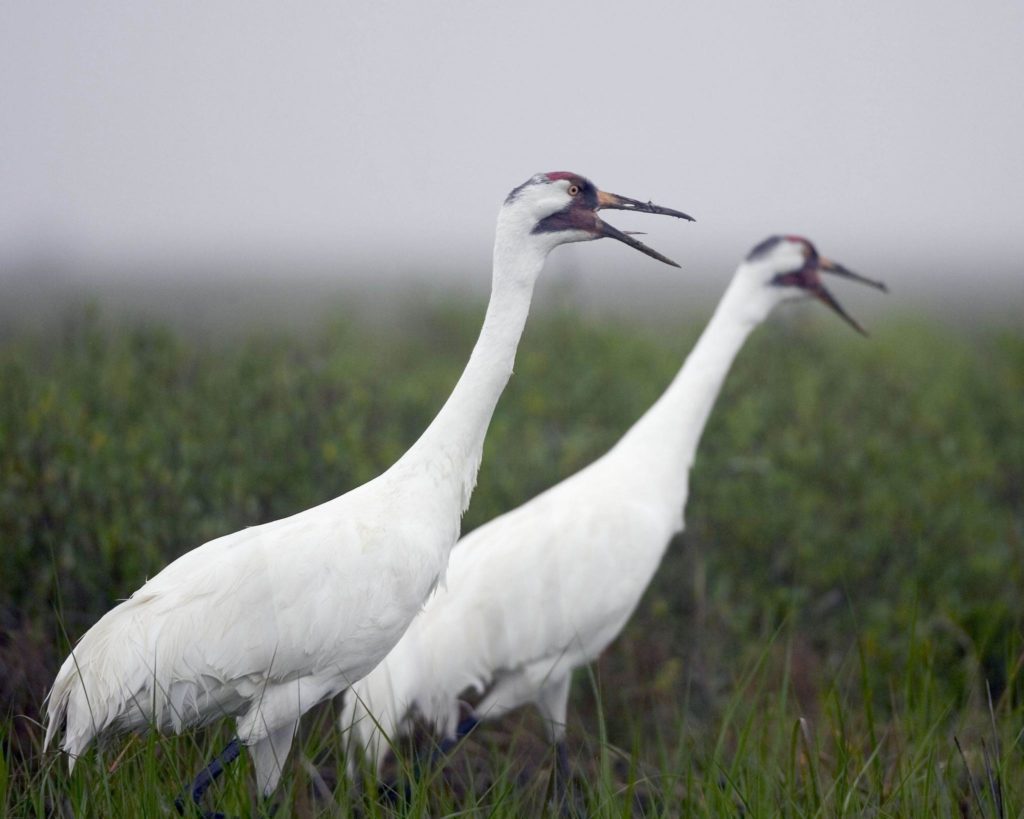
Source: Texas Parks and Wildlife Department | Nov. 3, 2020
With the first sightings of iconic, endangered whooping cranes along the Texas coast, the Texas Parks and Wildlife Department (TPWD) is reminding Texans to be on the lookout for these impressive birds as they move through the state.
Whooping cranes are the tallest, rarest birds in North America. Currently, there is a population of around 506 individuals. Thanks to coordinated conservation efforts, whooping cranes are slowly returning from the brink of extinction.
Whooping cranes make a 2,500-mile journey from their breeding grounds of northern Alberta’s Wood Buffalo National Park to the coastal marshes of Texas each year. The migration south to Texas can take up to 50 days.
During their migration, whooping cranes seek out wetlands and agricultural fields where they can roost and feed. The birds often pass large urban centers like Dallas-Fort Worth, Waco and Austin. Though whooping cranes rarely stay in one place for more than a day during migration, it is important that they not be disturbed or harassed at these stopovers. As a federally protected species, it is illegal to disturb or harass these birds.
Wade Harrell, the U.S. Fish and Wildlife Service (USFWS) Whooping Crane Coordinator at the Aransas National Wildlife Refuge (NWR), says that over half of the banded whoopers he studies have made their way to Texas. The first of the season was spotted in the Seadrift area on Oct. 19. Typically, Whooping Cranes arrive in pairs or family groups.
“The recent cold front really put the birds on the move southward,” Harrell said. “For the most part, all of the banded birds have moved out of Canada, but some are still as far north as the Dakotas and still in migration. Typically, we don’t have all the birds on the Texas Coast until December, so November is often our big month for migration sightings here in Texas.”
Once whooping cranes arrive on their wintering grounds, many stay in the same general area. Younger birds, however, often haven’t paired yet and may wander a little off their usual flight path, using areas quite distant from the Aransas NWR area.
Harrell says that due to the La Niña weather pattern forecast for this winter, the Southwest is in for a drier, warmer season, on top of the drought much of Texas is already experiencing. As such, freshwater wells on the Aransas NWR and surrounding areas will be very important for the whooping cranes upon their arrival. The USFWS is encouraging landowners to consider providing freshwater on their properties as well to aid the birds during their migration and wintering period.
With sandhill crane and waterfowl hunting seasons opening and whooper migration in full swing, TPWD urges hunters to be extra vigilant. Whooping cranes are sometimes found in mixed flocks with sandhill cranes, which are gray and slightly smaller. With their all-white body plumage and black wingtips, whooping cranes may also resemble snow geese, which are much smaller and have faster wing beats. A video detailing the differences between snow geese and whooping cranes can be found on the TPWD YouTube Channel.
There are several other non-game species that are similar in appearance such as wood storks, American white pelicans, great egrets and others, but a close look will reveal obvious differences. More information on look-alike species is available online.
The public can help track whooping cranes by reporting sightings to TPWD’s Whooper Watch, a citizen-science based reporting system to track whooping crane migration and wintering locations throughout Texas. More information about Whooper Watch, including instructions for reporting sightings, can be found online and by downloading the iNaturalist mobile app. These observations help biologists identify new migration and wintering locations and their associated habitats.
